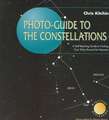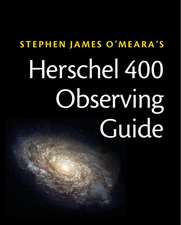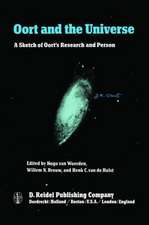Twenty-Five Astronomical Observations That Changed the World: And How To Make Them Yourself: The Patrick Moore Practical Astronomy Series
Autor Michael Marett-Crosbyen Limba Engleză Paperback – 28 iun 2013
This title contains graded observing challenges from the straightforward to the more difficult (in chapter order). It offers clear observing tips and lots of practical help, presuming no prior in-depth knowledge of equipment. Binoculars and/or a small astronomical telescope are all that is required for most of the observations.
Secondly, it explores for each observation the science of what is seen, adding to the knowledge and enjoyment of amateur astronomers and offering lots of reading for the cloudy nights when there is not a star in view.
Thirdly, the book puts the amateur astronomers' observations into a wider perspective. "Twenty-Five Astronomical Observations That Changed the World" makes the observer part of that great story of discovery.
Each chapter, each observing challenge, shows how to observe and then how to look with understanding. The projects begin with practicalities: where the object is, how best is it observed and with what appropriate equipment (usually a small-to-medium aperture amateur telescope, binoculars, even the naked eye).
"Twenty-Five Astronomical Observations that Changed the World" guides even the inexperienced amateur astronomer - beginners can use the book - around a variety of night-sky objects, and reminds the more experienced how they can best be seen. These practical observations put us in contact with all the history and culture surrounding them: through scientific speculation and literature to those first fuzzy images made in 1959 by the Russian space probe Luna 3.
Din seria The Patrick Moore Practical Astronomy Series
-
 Preț: 258.21 lei
Preț: 258.21 lei -
 Preț: 164.94 lei
Preț: 164.94 lei -
 Preț: 324.21 lei
Preț: 324.21 lei -
 Preț: 255.10 lei
Preț: 255.10 lei - 8%
 Preț: 581.98 lei
Preț: 581.98 lei -
 Preț: 159.16 lei
Preț: 159.16 lei -
 Preț: 282.38 lei
Preț: 282.38 lei -
 Preț: 308.55 lei
Preț: 308.55 lei -
 Preț: 309.87 lei
Preț: 309.87 lei -
 Preț: 332.98 lei
Preț: 332.98 lei -
 Preț: 276.91 lei
Preț: 276.91 lei -
 Preț: 243.94 lei
Preț: 243.94 lei -
 Preț: 183.40 lei
Preț: 183.40 lei -
 Preț: 378.09 lei
Preț: 378.09 lei -
 Preț: 302.20 lei
Preț: 302.20 lei -
 Preț: 210.01 lei
Preț: 210.01 lei -
 Preț: 212.68 lei
Preț: 212.68 lei -
 Preț: 271.39 lei
Preț: 271.39 lei -
 Preț: 252.91 lei
Preț: 252.91 lei -
 Preț: 281.95 lei
Preț: 281.95 lei -
 Preț: 289.85 lei
Preț: 289.85 lei -
 Preț: 218.84 lei
Preț: 218.84 lei -
 Preț: 282.38 lei
Preț: 282.38 lei -
 Preț: 128.86 lei
Preț: 128.86 lei -
 Preț: 301.10 lei
Preț: 301.10 lei -
 Preț: 204.78 lei
Preț: 204.78 lei -
 Preț: 307.44 lei
Preț: 307.44 lei -
 Preț: 303.07 lei
Preț: 303.07 lei -
 Preț: 258.83 lei
Preț: 258.83 lei -
 Preț: 155.25 lei
Preț: 155.25 lei -
 Preț: 193.97 lei
Preț: 193.97 lei -
 Preț: 208.26 lei
Preț: 208.26 lei -
 Preț: 279.09 lei
Preț: 279.09 lei -
 Preț: 303.51 lei
Preț: 303.51 lei -
 Preț: 277.54 lei
Preț: 277.54 lei -
 Preț: 208.51 lei
Preț: 208.51 lei -
 Preț: 214.86 lei
Preț: 214.86 lei -
 Preț: 304.58 lei
Preț: 304.58 lei -
 Preț: 220.57 lei
Preț: 220.57 lei -
 Preț: 157.32 lei
Preț: 157.32 lei -
 Preț: 275.98 lei
Preț: 275.98 lei -
 Preț: 288.98 lei
Preț: 288.98 lei -
 Preț: 261.49 lei
Preț: 261.49 lei -
 Preț: 279.09 lei
Preț: 279.09 lei -
 Preț: 160.82 lei
Preț: 160.82 lei -
 Preț: 327.01 lei
Preț: 327.01 lei -
 Preț: 254.90 lei
Preț: 254.90 lei -
 Preț: 304.38 lei
Preț: 304.38 lei -
 Preț: 256.84 lei
Preț: 256.84 lei
Preț: 280.37 lei
Nou
Puncte Express: 421
Preț estimativ în valută:
53.65€ • 56.16$ • 44.39£
53.65€ • 56.16$ • 44.39£
Carte tipărită la comandă
Livrare economică 07-21 aprilie
Preluare comenzi: 021 569.72.76
Specificații
ISBN-13: 9781461467991
ISBN-10: 1461467993
Pagini: 332
Ilustrații: XIV, 318 p. 126 illus., 83 illus. in color.
Dimensiuni: 155 x 235 x 17 mm
Greutate: 0.66 kg
Ediția:2013
Editura: Springer
Colecția Springer
Seria The Patrick Moore Practical Astronomy Series
Locul publicării:New York, NY, United States
ISBN-10: 1461467993
Pagini: 332
Ilustrații: XIV, 318 p. 126 illus., 83 illus. in color.
Dimensiuni: 155 x 235 x 17 mm
Greutate: 0.66 kg
Ediția:2013
Editura: Springer
Colecția Springer
Seria The Patrick Moore Practical Astronomy Series
Locul publicării:New York, NY, United States
Public țintă
Popular/generalCuprins
From the Contents: The Eye of the Moon.- Don't Look! - The Sun.- The Ways Stars Work - Ursa Major.- What Galileo Saw - The Moons of Jupiter.- Orion's Five - The Types of Stars.- The Little Cloud - Andromeda.- The Joy of Red - Getting to Know Mars.- Orion and its Nebula - Suns Present and Suns Future.- Bright Dog of the Night - Sirius.- Looking for Footsteps.- The River in the Sky - Eriidanus.- Saturn - Falling in Love.- Algol - Splitting the Demon Star.- Comets, Asteroids, and Meteorites - Where everything comes from.- Uranus - Strange, or what?.- Hubble V1 - How it destroyed a Universe.
Recenzii
“This book shows how not everything has been so throughout the history of astronomy, and how observations of some objects and details on them have changed the way that humankind views the Universe or their place in it. … I found that it is an excellent book … . I think it's a better first books for observations than any big atlas or guide to specific types of objects. Perfect book to accompany a first telescope.” (AstroMadness.com, December, 2016)
“This book may provide an incentive for some undergraduate students and general readers to observe objects that they might not otherwise consider. Marett-Crosby, an amateur astronomer in the UK, places many of the historical observations in context. … useful for novice astronomical observers. Summing Up: Recommended. … Lower-division undergraduates and general readers.” (J. R. Kraus, Choice, Vol. 51 (7), March, 2014)
“This book may provide an incentive for some undergraduate students and general readers to observe objects that they might not otherwise consider. Marett-Crosby, an amateur astronomer in the UK, places many of the historical observations in context. … useful for novice astronomical observers. Summing Up: Recommended. … Lower-division undergraduates and general readers.” (J. R. Kraus, Choice, Vol. 51 (7), March, 2014)
Notă biografică
Dr. Marett-Crosby obtained both an MA and PhD from the university of Oxford. After working as a pastoral counselor in academia and in the UK prison service (as a counselor and educator), he became, in 2005, a full-time writer working from his home on the channel island of Jersey. His published books include The Conversion of England (Abbey Press 1998); the majority of Doing Business with Benedict (Continuum 2002). His most recent project is a novel, Two Thirds Man, which is currently with agents. Parts of this novel have already won national short story prizes. He speaks and writes on astronomical subjects, and believes practical astronomy is important in building bridges between science and the liberal arts.
A lifelong student of astronomy, he has been an enthusiastic amateur astronomer for most of his life, and is fortunate to be able to view the night sky from the enviable viewpoint of the UK’s southernmost outpost.
A lifelong student of astronomy, he has been an enthusiastic amateur astronomer for most of his life, and is fortunate to be able to view the night sky from the enviable viewpoint of the UK’s southernmost outpost.
Textul de pe ultima copertă
Human history is also the record of our fascination with the sky, and to look upwards is to follow in the steps of such greats as Galileo and Newton. What they and others once saw in the heavens for the first time, amateur astronomers can discover anew using this guide to twenty-five of the greatest journeys through space.
Starting with our most visible companion the Moon, each chapter offers a step-by-step walk-through of famous astronomical observations from the history of science. Beginning with the easiest targets, sometimes even accessible with the naked eye, the challenges become progressively more difficult. Beginner astronomers and more experienced hobbyists alike can reacquaint themselves with the wonders of our fellow planets and even reach far beyond our own solar system to touch on such incredible phenomena as the birth of new stars in nebula systems and the deceptive nothingness of black holes. The would-be astronaut can spy the International Space Station in orbit with binoculars or the doomsday prophet can search for new comets. Along the way, easily digestible mini-lessons inform the reader on the initial discovery of then-new celestial bodies and subsequent advances in our understanding of the cosmos.
Relying only on binoculars or small astronomical telescopes for most of the observations, and including background on the science of each phenomenon, this exploration of the skies is easy to follow and packed with useful information and fun tidbits. These practical observations put us in contact with all the history and culture surrounding them: through scientific speculation and literature to those first fuzzy images made in 1959 by the Russian space probe Luna 3.
Starting with our most visible companion the Moon, each chapter offers a step-by-step walk-through of famous astronomical observations from the history of science. Beginning with the easiest targets, sometimes even accessible with the naked eye, the challenges become progressively more difficult. Beginner astronomers and more experienced hobbyists alike can reacquaint themselves with the wonders of our fellow planets and even reach far beyond our own solar system to touch on such incredible phenomena as the birth of new stars in nebula systems and the deceptive nothingness of black holes. The would-be astronaut can spy the International Space Station in orbit with binoculars or the doomsday prophet can search for new comets. Along the way, easily digestible mini-lessons inform the reader on the initial discovery of then-new celestial bodies and subsequent advances in our understanding of the cosmos.
Relying only on binoculars or small astronomical telescopes for most of the observations, and including background on the science of each phenomenon, this exploration of the skies is easy to follow and packed with useful information and fun tidbits. These practical observations put us in contact with all the history and culture surrounding them: through scientific speculation and literature to those first fuzzy images made in 1959 by the Russian space probe Luna 3.
Caracteristici
Traces the history of important discoveries in astronomy and combines these with practical observational projects and tips Discusses the impact of astronomical discoveries on human history and culture Covers a wide range of interests, from the Solar System to deep sky objects, star clusters, binaries, etc. Includes supplementary material: sn.pub/extras











